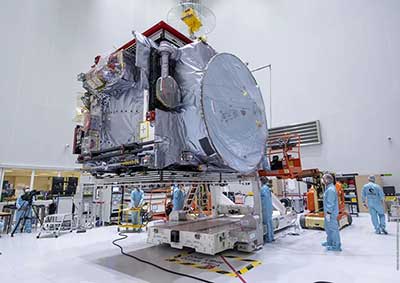Date: 18/04/2023
Relevance: GS-3: Science and Technology- Developments and their Applications and Effects in Everyday Life; Awareness in the fields of Space.
Key Phrases: European Space Agency, Europa Clipper, NASA, Jupiter Icy Moons Explorer (JUICE), Indian Space Research Organisation (ISRO), Ganymede, JUNO mission.
Context:
- Recently, the European Space Agency's Jupiter Icy Moons Explorer (JUICE) craft was launched by the Ariane 5 rocket at the European spaceport in Kourou, French Guiana.
Key Highlights:
- Europa Clipper is an interplanetary mission in development by
NASA comprising an orbiter.
- It is planned for launch in October 2024, the spacecraft is being developed to study the Galilean moon Europa through a series of flybys while in orbit around Jupiter.
- JUNO is a NASA space probe orbiting the planet Jupiter.
- It was launched in 2011 and entered a polar orbit of Jupiter in 2016 to begin a scientific investigation of the planet.
European Space Agency’s JUICE Mission:
- The JUICE probe will get close to three of the four large moons of
Jupiter and will eventually circle around Ganymede and search for
evidence of a hidden ocean beneath its icy surface.
- If successful, it will be the first time that any spacecraft has orbited a natural satellite other than Earth’s Moon.
- If everything goes according to plan, the probe will circle back and
pass close to both Earth and the Moon in around one year’s time, which
will help to slingshot the spacecraft towards the outer Solar System.
- This double fly-by will require “the most accurate gravity-assist manoeuvre” ever done.
- JUICE’s trajectory will be as following:
- It will first make a Venus fly-by, in 2025 - which will expose it to high temperatures — after which it will fly past Earth twice more, in 2026 and 2029.
- It will arrive at Jupiter in 2031, at which point its main engine will perform a long retro-burn to slow down and begin orbiting the planet.
- Whereas JUICE is scheduled to do 21 fly-bys of Jupiter’s
second-largest moon Callisto, it will only pass the smallest
Galilean moon, Europa, twice.
- That’s because Europa will be studied closely by a NASA mission called Europa Clipper, which is due to launch in late 2024.
- In 2035, JUICE will fire up its main engine again to enter orbit
around Ganymede for at least 9 months.
- This will be a delicate manoeuvre.
- Loaded with 3.5 tonnes of propellant, JUICE weighs nearly 6 tonnes. On its journey, it will deploy 85 square metres of solar panels — the bare minimum for operating around Jupiter, where solar energy is only 4% as powerful as on Earth.
- JUICE will also deploy a plethora of booms and antennas for its ten onboard instruments, which were built by teams in France, Germany, Italy, the Netherlands, Sweden and the United States.
- Hidden oceans:
- Some of Jupiter’s icy moons are thought to harbour liquid water underneath their predominantly water-ice surfaces - potentially providing an environment for some form of life to have evolved.
Jupiter
- Jupiter is the fifth planet from the Sun and the largest in the Solar System.
- It is a gas giant with a mass more than two and a half times that of all the other planets in the Solar System combined.
- Jupiter is the third brightest natural object in the Earth's night sky after the Moon and Venus.
- Jupiter is primarily composed of hydrogen (90% by volume), followed by helium, which constitutes a quarter of its mass and a tenth of its volume.
- Jupiter is surrounded by a faint planetary ring system and has a powerful magnetosphere.
- Jupiter has approximately 95 known moons and probably many
more, including the four large moons discovered by Galileo Galilei
in 1610 such as Io (Jupiter I), Europa, Ganymede, and Callisto.
- Bigger than the planet Mercury, Ganymede is the largest moon in the Solar System, and the only one known to currently have its own magnetic field.

Way Forward:
- One of the most conclusive tests of the ocean theory will come
from topographical maps made by JUICE’s laser altimeter.
- Because Ganymede moves slightly closer to and farther from Jupiter during its weekly orbit, and because it experiences the gravitational pull of the other moons, it stretches and compresses under tidal forces.
- On a water world with an ice crust, such deformations might make the surface swing up and down by as much as 10 metres.
- As well as mapping the icy moons’ surfaces, these instruments will also study the chemistry of the satellites’ thin atmospheres, Jupiter’s strong magnetic field and radiation belts, and more.
Conclusion:
- By the time JUICE and Europa Clipper arrive, Juno will have long
exhausted its propellant and ended its mission.
- But researchers are excited at the prospect of having two probes in the system at the same time, which could enable simultaneous measurements of Jupiter’s magnetic field at two locations.
- Both missions are scheduled to end with a controlled crash landing on Ganymede’s surface.
Source: Nature-Journal
Mains Question:
Q. What do you know about ESA’s JUICE mission? How will it be useful for scientific research? (250 Words).






















